Magento SEO | A Practical & Easy Guide to Magento 2 SEO Settings in 2025
Magento is one of the most powerful eCommerce platforms. While Magento is search engine optimisation (SEO) friendly, merchants need to configure the relevant settings correctly. As the title indicate, this article will discuss everything there is to know about Magento 2 SEO 2025, including configuring the Magento 2 SEO settings and improving your store’s ranking. Specifically, we will focus on the following points:
- Product keyword research & buyer's intent
- Setting a SEO-friendly URL
- How to write SEO-friendly title tags, meta descriptions and alt text
- Optimising product page content
- Technical SEO optimization in Magento
- Advanced Off-page SEO tactics
- Lots more
1. Magento SEO - Keyword Research
The first step in your Magento SEO journey is the keyword research. Think of it as the foundation i.e. all other aspects of SEO are built upon keyword research. If you select the wrong keywords to target, all subsequent efforts such as off-page optimisation or technical SEO become irrelevant. Therefore, it’s very important that you find the right keywords for your product and category pages.
1.1. How to Research & Choose Keywords for your Magento Product & Category Pages?
You need to hunt keywords that give you sales. Since you will be selling products on your Magento store, your keywords should be product-specific with users intending to buy. Following are the three dimensions to consider while doing keyword research.
- Competition
- Monthly Search Volume
- Buyer’s Intent
Finding the perfect balance of competition, search volume and buyer’s intent is challenging. Ideally, you should be aiming for keywords that have high search volume with good buyer’s intent. This often comes with high competition. Keywords that have high search volume are highly competitive as everybody else is trying to rank for them. Low search volume keywords are often less competitive.
1.2. The Challenge
If you go after highly competitive keywords (with high search volume), you will face tough competition in ranking your website against these keywords. The reason is that others are competing for the same keywords, and they may have much bigger marketing budget than yours.
On the other hand, choosing low competitive keywords (with low or no search volume) means less people or no one will search for your products. So how to find the perfect balanced keywords? We will look at it later. First, let’s understand buyer’s intent because it holds the answer to this problem.
Understanding Buyer’s Intent
User intent describes what a user is looking for when they conduct a search query. They may be looking to find some information, get to another site or buy a product. Your selection of keywords for your site will determine with what intent users will access your site.
There are four types of search intent:
Navigational
Users are trying to find a specific information i.e. webpage. For example, they may search for FME Extensions Black Friday Cyber Monday Sale.
Informational
They may want to learn something such as ‘how to add a checkbox in Magento 2 checkout fields’.
Commercial
In this case, the users are trying to gather as much informational as possible before finalising a purchase. For example, ‘best Magento 2 content delivery networks’.
Transactional
This refers to when a user wishes to perform a specific action. In most cases, this is the stage where user completes the purchase. For example, ‘buy wooden outdoor chairs’.
Understanding the buyer’s intent is crucial for keyword research. If you are driving traffic to your store with low buyer’s intent, you will have a high bounce rate and low conversion rate. People may come to your store but will not stick around as you don’t offer what they are looking for. Also, your page might rank well but the product you are trying to sell could have little to no conversions at all.
For example, if your page sells an SEO extension for Magento 2, the keyword “Magento 2 SEO extension” has a high buyer’s intent than the keyword “Magento 2 SEO”. The former indicates that the user is looking to buy an SEO extension while the latter is a broader keyword which the user can search to find information about SEO for their Magento 2 store.
1.3. The Solution
Place your content in context with the volume of the keywords. Judge how likely a particular keyword is going to result in engaged users, along with the value of your content. Initially, go for long tail or niche keywords as they have high buyer’s intent. They are easier to rank for and high converting.
At the end of the day, it’s better to have low but targeted traffic than to have high traffic with no conversions It’s better to rank for low competitive keywords that generate revenue in the first 3 months than being unable to rank for highly competitive keywords in the entire year.
1.4. Some Prominent Free & Paid Keyword Research Tools
- Google Keyword Planner (Free)
- Ahrefs Keyword Explorer (Paid)
- KeywordTool.io (Free)
- Moz Keyword Explorer (Paid)
- SEMRush (Paid)
2. Magento 2 SEO Optimisation – On-Page Settings
By now, you will have collected a list of keywords that you would like to rank for. Now it’s time to optimize your product and category pages for these keywords. These two pages will generate most of your traffic and sales. When we are talking about on-page SEO, the following factors hold special importance.
- URL Structure
- Meta Title
- Meta Description
- Page Content
- Image Alt text
- Internal Links
- Product Information
Let’s see how to optimize them.
2.1. URL Structure
Your URLs should be:
- Short
- Keyword rich
- No special characters
- Lower case
- Consistent
2.2. Optimizing Meta Title
Meta title acts as a name tag for the web page. It briefs search engines what the page is all about. Search engines display Meta title as clickable headline in its search result pages.

Meta title is the most important place to place your keyword. Since you can prolong meta title up to 60 characters, its best to add modifiers such as “best”, “top” “cheap”, “high-quality” or your brand name to it. It will help you rank for more long tail searches.
It’s also wise to add words that encourage users to click on your search result. Words like “% OFF”, “Ultimate”, “Free Shipping” can significantly increase your CTR (Click Through Rate).
So instead of just making your keyword “Magento 2 SEO Extension” as your Meta title, you can optimize it a little further like “The Best Cheap Magento 2 SEO Extension | 30% OFF”.
2.3. Optimizing Meta Description
Although Meta description is not a direct SEO factor, an optimized description will help increase your page’s CTR. Meta description is displayed in SERPs just below Meta title.
You can write a description of up to 160 characters, so you have more room to add enticing words and phrases in addition to your keywords. Try to include phrases like the following to get more clicks. You can also include distinguishing features of your product to grab customer’s interest.
“We are running a X% Off on all our products for a limited time.”
“Get FREE shipping on all our products today.”
“Get heavy discounts on _ today.”
Unfortunately, this is the part where most websites owner get it wrong. If you do a quick Google search, you will notice that most owners do not adhere to the character limit. The meta descriptions are too long which Google and other search engines discourage. Additionally, they do not include the keywords.
We are not asking to you add the keywords forcefully since it goes against SEO guidelines. Ask your copywriter or SEO write to find a way to add the primary or at least the secondary keyword in a natural manner. This will not only boost your rankings in the search results, but also improve the click through rate.
2.4. Optimizing Page Content
Writing content that satisfies both users and search engines is the hardest part. You not only have to sell your product to customers but also convince search engines that your product page is worthy of ranking above your competitors. Here is how you can do this:
Cover Your Product from Every Angle
The more content you provide about your product, the better. Long content tends to rank best. It signals search engines that you have the most in-depth product knowledge while customers also get everything that they need to know. Cover every area of the product. Take your product’s descriptions to 1000+ words.
Include Keyword Multiple Times
Make sure to include your targeted keywords at least 3 times. Don’t make it look like you have forcefully included them though. Just use them contextually. It will help Google understand what your page is all about.
Use LSI Keywords
LSI (Latent Semantic Indexing) keywords are keywords that are closely related to or synonyms of your primary keywords. Google displays LSI keywords at the bottom of SERPs. They help search engines deeply understand the page’s overall topic and bring authority to the content.
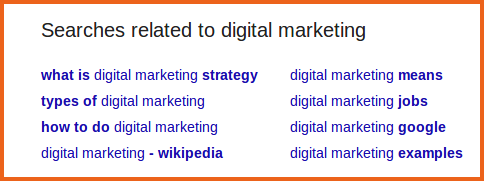
2.5. URL, Meta Titles and Descriptions Settings in Magento 2
Choose a particular CMS page by going to Content > Pages > Edit from Magento 2 backend. Now expand the Search Engine Optimization section. Here you can update the Meta title and description for the page. Click Save when you are done and it will be displayed on the front end.
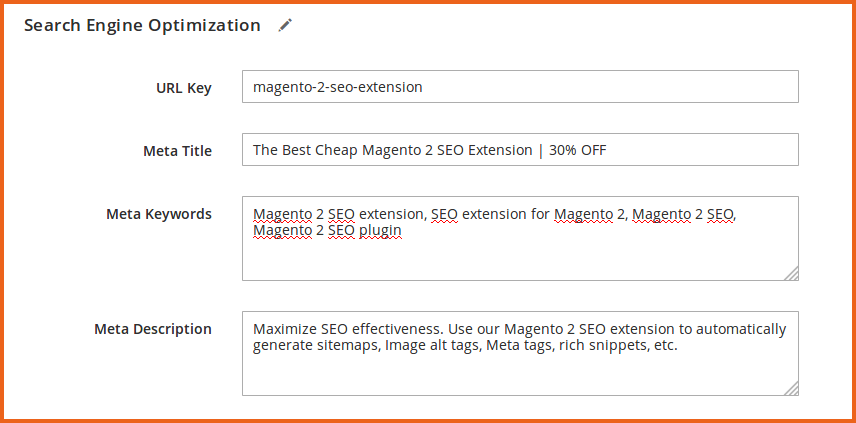
If you have thousands of product pages in your store, it's a cumbersome task to generate SEO optimized Meta titles for all of them. Keeping this in mind, we have developed an SEO Meta tags generator that will automatically generate SEO Meta titles for your store pages.
2.6. Set up a Blog
One of the biggest shortcomings in Magento 2 is that it does not have any built-in blog feature. In other words, if you wish to add a blog section, there is no option except through custom code or using a third-party extension. Most merchants do not understand the true value of a blog since they believe that only the product pages matter most in an eCommerce site.
This is only partially true. The reason is that blogs can be helpful in communicating important information about the product. For instance, FME provides Magento extensions such as the Percentage Pricing for Magento 2. To boost this extension’s sales or to provide the consumers with an overview of its features, we can write different blogs on it. Once the blogs start to rank, it will increase traffic to the product page.
For example, refer to our article on ‘Best Magento 2 Marketplace Extensions to Boost Sales in 2024 Holiday Season’. The article provides an overview of how different extensions, including the Percentage Pricing for Magento 2 can boosts sales during the holiday period. Likewise, other blog titles can be used to highlight specific features and other aspects of the extension.
Earlier, there was a discussion on different types of keywords. Well, a blog is a great way to utilise informational keywords. If you are looking for ways to set up a blog in your Magento 2 store, refer to FME’s Magento 2 Blog Extension. The extension allows you to configure SEO details for the posts, categories, and more.
Before we move towards the next point, you need to understand that blogs require continuous updates. So, whenever there is a change in the product, ensure that the same is reflected in the blog. Likewise, if you have a blog such as ‘Best Magento 2 Extensions 2024, don’t forget to update it to ‘Best Magento 2 Extensions 2025’ once the new year is around the corner. This ensures that the content stays evergreen.
2.7. Product Structured Data
This data type helps Google and other search engines understand the context of a page. There are several benefits of adding this data in your Magento 2 store. First, product schema can trigger product snippets in search results. This is what a rich snippet looks like in search results.
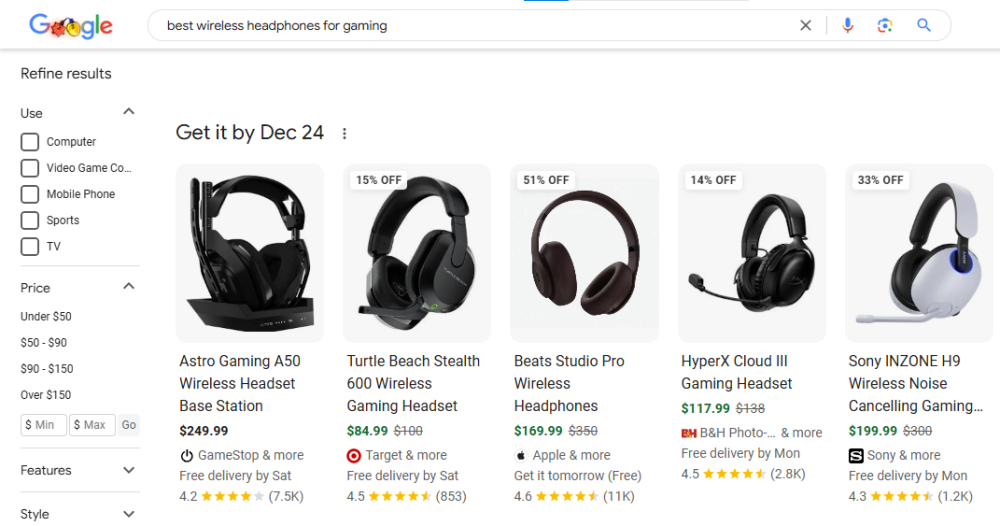
Source: Google Search
The snippet provides all the information in a concise, visual manner. In this case, users can see the prices, delivery schedule, and reviews. This allows them to make an informed decision promptly. Additionally, product schema helps with voice search optimisation. Voice assistants like Siri can easily pull your product’s information if it contains product schema. Therefore, add all relevant information such as name, SKU, price, and image.
Take advantage of our Magento 2 Rich Snippets Extension.
3. Magento SEO – Technical SEO
Don’t forget to fix the technical aspects of your website when trying to rank it. Technical SEO is as important as on-page or off-page SEO. It makes sure that technically there is nothing that hinders your website from ranking well. Technical SEO helps search engines crawl and index your site more effectively. One minor mistake here and you will be punished heavily.
Following is the technical SEO checklist.
- Robots.txt
- Sitemaps
- Redirects
- Content duplication issues
- HTTPs
- Site speed
3.1. Technical SEO Optimization in Magento 2
Magento allows you to configure technical SEO settings from within its Admin panel.
Robots.txt
Robots.txt is a file that tells search engine crawlers which pages on your site to crawl and which not to crawl.
- From Magento 2 Admin, go to Content > Design > Configuration.
- Click Edit for the website in the Action column.
- Expand the Search Engine Robots section.
- Choose one of the 4 options in the Default Robots dropdown.
- Make changes to the Edit custom instruction of robots.txt field.
For example, if you want crawlers not to crawl your checkout page, you can add the custom instruction Disallow: /checkout/.
- Click Save Configuration.
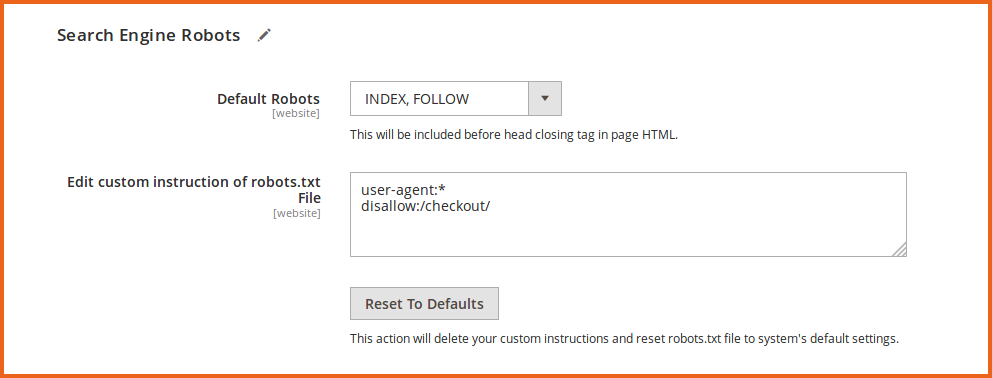
You can find robots.txt file at mysite.com/robots.txt. It’s better to make changes in the default configuration and disallow these.
directories:/catalogsearch/,/catalog/product_compare/,/wishlist/
You can automate this with our noindex nofollow tag module.
XML Sitemap
The XML sitemap file contains links of all the pages on your site available for crawling. It gives search engines a road map of the content on your website which makes their job easy.
First, you have to enable submission to robots.txt which will submit the URL of your XML sitemap to your robots.txt.
- Go to Stores > Settings > Configuration > Catalog > XML Sitemap.
- Expand the Search Engine Submission Settings section.
- Change Enable Submission to Robots.txt to Yes.

To generate a sitemap.xml file in Magento 2:
- Click on Marketing > SEO & Search > Site Map.
- Click Add Sitemap. In the New Site Map view, enter the following values:
- Filename:sitemap.xml
- Path:/media/
- Click Save & Generate. The new site map becomes available in the Site Map grid.

Use our XML & HTML sitemap extension to automatically generate sitemaps for your Magento 2 store.
Redirects & URL Rewrite Settings in Magento 2
You can optimize the default settings for redirects and URL rewrites. You can also add new redirects. Let’s look at the default settings first.
- Go to Stores > Settings > Configuration > General > Web.
- Under Url options:
- Keep Add Store Code to Urls to its default No to make sure URLs are descriptive and easy to read.
- Change Auto-redirect to Base URL to Yes (301 Moved Permanently) to make sure link authority is passed on.
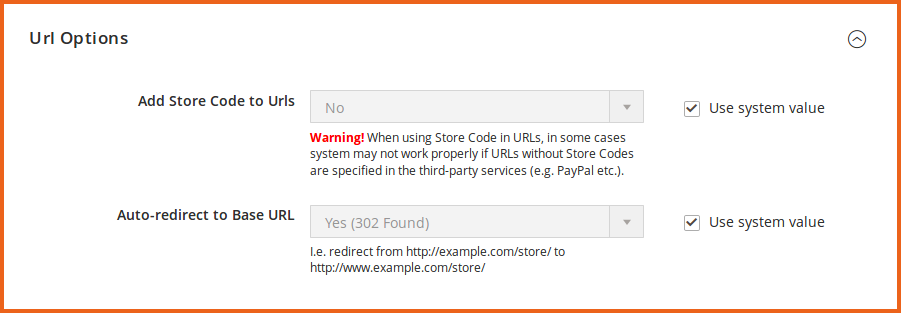
To Create 301 Redirects in Magento 2
- Go to Marketing > SEO & Search > URL Rewrites.
- Click Add URL Rewrite.
Fill in the following 2 mandatory and important information.
Request Path: Enter the path you want to redirect.
Target Path: Enter the path you want to be redirected to.
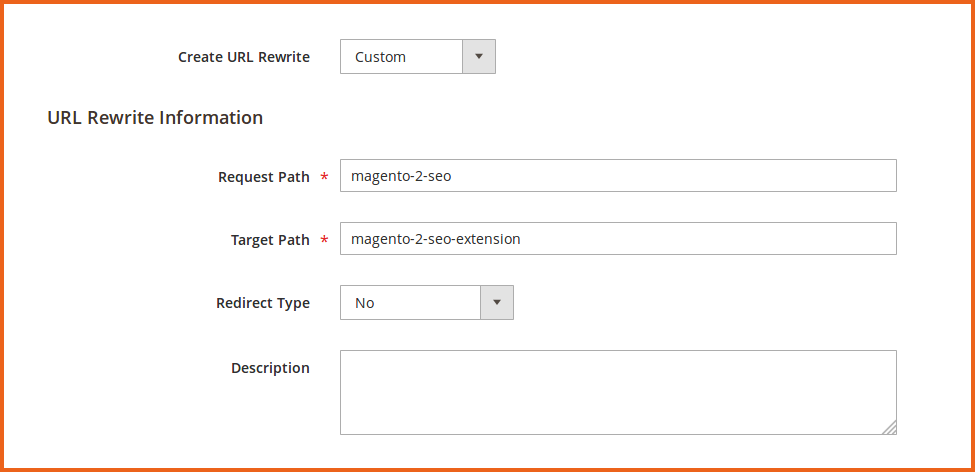
Content Duplication Issues
Duplicate content is one of the most common SEO issues in ecommerce stores. This happens mainly due to a lot of unique URLs for product & category pages with almost the same content. For example, multiple product or category pages may have the same or very similar content i.e. product descriptions, features, guidelines etc. This can also happen if you have a snippet of text that appears on multiple pages.
To solve this issue, canonical tag is used. We already have a detailed blog on ‘How to Fix Duplicate Content Issues in Magento 2?’. Go through it and reach out to us if you have any questions. In simple words, store admins must a canonical tag to avoid content duplication issues. The tag tells search engines that this page is an exact copy of the destination URL () and hence should not be treated as a unique page.
To turn on the use of canonical URLs in Magento 2:
- Go to Stores > Settings > Configuration > Catalog > Search Engine Optimization.
- Turn both Use Canonical Link Meta Tag for Categories and Use Canonical Link Meta Tag for Products to Yes. This will result in both product and product-category pages having canonical URLs.

We have a Magento 2 Canonical URL Extension with lots of features that will help you avoid content duplication issues even if you don’t have technical knowledge. Apart from this, Magento’s in-built canonical tag feature is not ideal for handling pagination or layered navigation issues. In contrast, this extension allows for a coding-free way to manage all these aspects.
HTTPs
Nothing is more important for a customer shopping online than security. It’s of utmost importance that you serve them over a secure connection.
To enable HTTPs in Magento 2:
- Go to Stores > Settings > Configuration > General > Web.
- Expand the Base URLs (Secure) section.
- Change the Use Secure URLs on Storefront and Use Secure URLs in Admin to Yes.

Site Speed
Speed is the only thing that affects your rankings, conversions and user experience all at the same time. The fact that 40% of customers abandon a site if it takes more than 3 seconds to load is enough to understand the importance of speed.
Fortunately, Magento 2 has an efficient caching system that reduces a store’s loading time and greatly improves its performance. For a fast-loading Magento site, make sure you have the best hosting platform so that there is no delay from server side. Investing in a good web hosting will eventually pay off. Your hosting platform should be:
- Optimized for Magento
- Ready to support Redis and Varnish
- Running on Nginx
- CDN compatible
More Details: Recommended Magento 2 Web Hosting Services
Large images are one of the most common reasons of slow-loading websites. Make sure to compress all your images without compromising their quality so that their sizes are minimum. It's best to convert images to webp which is Google's recommended image format.
To enable caching features in Magento 2:
- Go to System > Tools > Cache Management.
- Mark all checkboxes, select Refresh from the drop-down box, and click Submit.
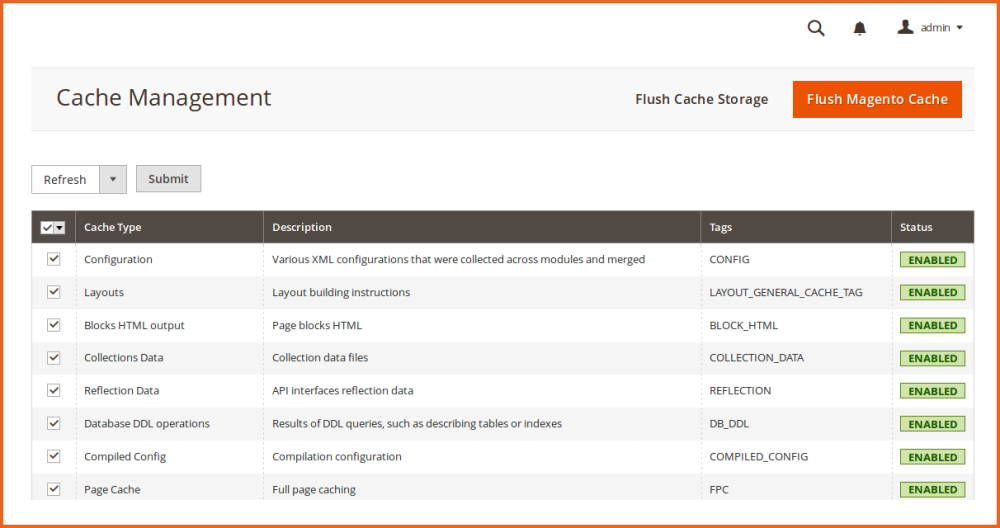
4. Magento 2 Off-Page SEO
By now, you have established a solid relevancy and technical base for your Magento store. You have effectively conveyed to search engines what your site is all about through on-page SEO and made indexing and crawling easier for them through technical SEO. Now it’s time to increase your site’s exposure and authority in the digital world which is done through off-page SEO.
Off-page SEO is synonymous to link building. Google uses links from other websites to your website to determine your website’s popularity and consequently assign you a ranking. For high quality backlinks, it’s important that your linking domains are:
- Relevant (For example, a shoes online store obtaining link from a gaming website is considered a poor link)
- Have good domain authority
- Trustworthy
- Have unique, fresh, and useful content
There are broadly 3 ways to obtain backlinks.
Natural Links: These are the links that third party websites give you without any action on your part. Such websites may have found your content highly relevant and useful for their own audience. To earn such links, your content must be of high quality so that other websites in the industry can’t resist linking to you.
For example, lots of SEO related websites will willingly link to Neil Patel, Moz, or Search Engine Land for the benefit of their own audience.
Manually Built Links: Such links are acquired through link building activities such as guest blogging, outreach, and influencer marketing. When done correctly, these back links can significantly contribute to your site’s high ranking and traffic.
Self-Created Links: These link building practices can sometimes do more harm to your website than good. They come under black hat SEO and include adding a backlink in an online directory, forum, blog comment signature, or a press release with optimized anchor text.
To start off getting backlinks for your Magento 2 store, participate actively in all the Magento 2 forums. These forums have your targeted audience that might be looking for solutions. Help them by answering their queries and in the process direct them to your store.
Devise an effective guest blogging strategy to post your content on relevant high DA websites with a link back to your website. This will help you establish your authority in Magento community. Reach out to Magento experts or influencers to market your store on their blogs/channels.
Need a Magento SEO Expert for your Website?
We understand that addressing all the above SEO points can be a challenge even for someone who is knowledgeable in Magento SEO. Apart from this, you would need a dedicated team for this purpose. The reason is that a single individual cannot address on-page, off-page, and technical SEO themselves. Therefore, if you are looking for a reliable Magento SEO partner, FME is the answer.
While we specialise in Magento extension development, we offer a wide range of other complementary services, including Magento SEO. In other words, we are a one-stop solution for all your SEO needs. We have a dedicated SEO team who have the expertise and knowledge to tackle any project across any niche. To know more about our SEO services and the cost, reach out to our team.
What to Look for in a Magento SEO Services Provider?
When you are looking for engage someone for Magento SEO Services, keep the following points in mind:
- Expertise
How much experience does the agency or individual have? Naturally, the more experience the better. Of course, you will have to balance the experience against your budget since higher experiences means more cost. FME has more than 20 years’ experience in Magento SEO. Over the years, we have developed resources and processes that guarantee results.
- Results
It is not enough to have experience alone. You need someone who delivers results. After all, if you are going to spend thousands of dollars per month on SEO, you need to see improvements. In eCommerce, the most valuable metric is the conversions. FME’s SEO strategy revolves around maximising your sales. Don’t worry as we don’t use black hat SEO. All our work complies with search engine rules and policies.
- Customised Strategy
Additionally, you need to ensure the SEO services provider does not follow a one-size fits all strategy. Each website is unique, meaning it requires a customised strategy. This is one of the hallmarks of FME’s approach to SEO. During the initial meetings, our sole purpose is to gather information about your website, including the bottlenecks. Based on this, our SEO experts come up with a comprehensive SEO strategy that is tailored to your requirements.
- Transparency
Lastly, you need to ensure that the SEO services provider is transparent. If the individual or company are hesitant to share their processes or provide reports regarding the keyword rankings or organic growth, then this is a cause for concern. At FME, we place the client at the heart of every process. We share regular reports and address all queries promptly. We have nothing to hide and encourage the client to participate in weekly meetings and go through the reports.
Final Thoughts on SEO for Magento 2 in 2025
SEO is a continuous process, so you must constantly review its performance. Apart from this, keep adding or updating quality content, earn quality backlinks, and keep an eye on the competitors. With the right strategy and consistency, you can occupy the coveted #1 ranking. Of course, you can’t rest once you reach the top spot. Before you know it, your competitors will outrank your webpage if you are not continuously improving.
Related Articles:
This blog was created with FME's SEO-friendly blog


